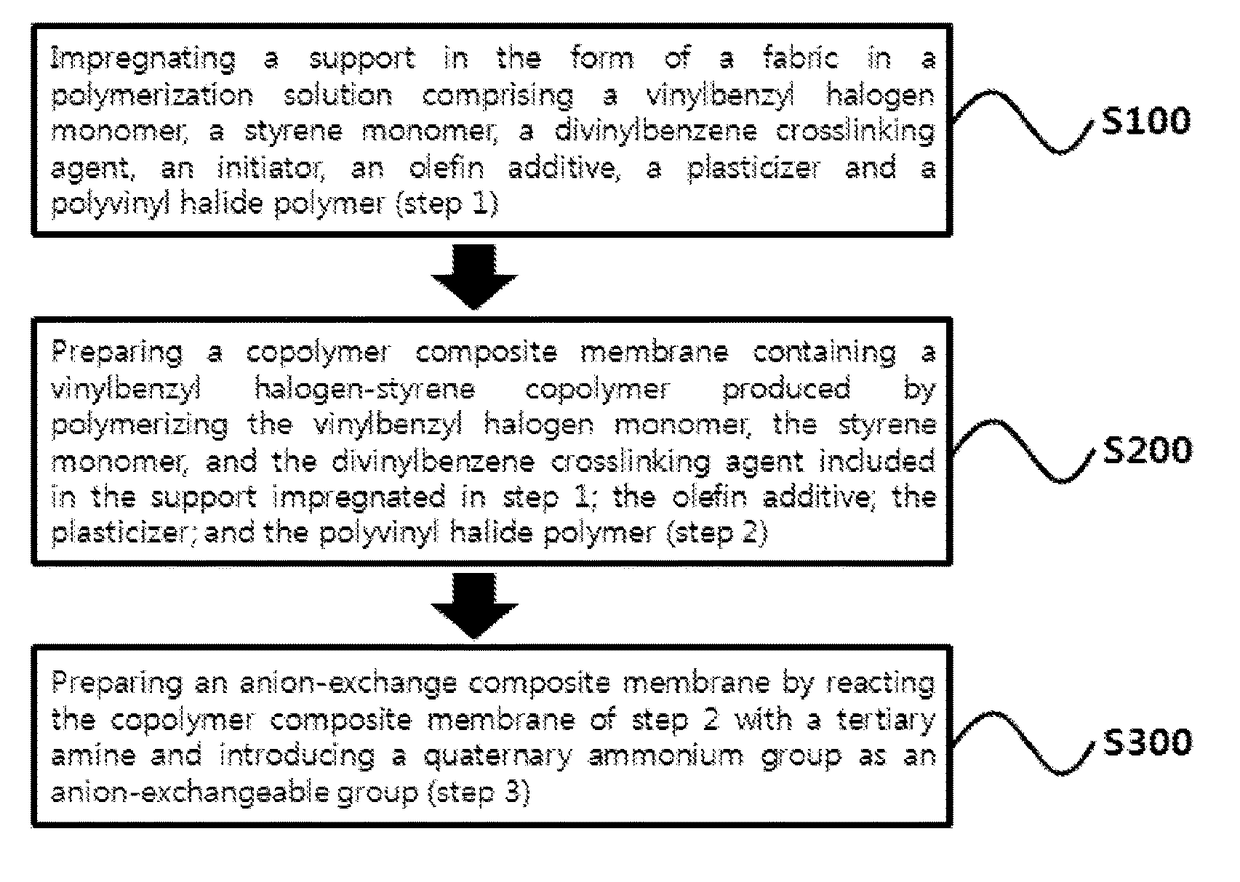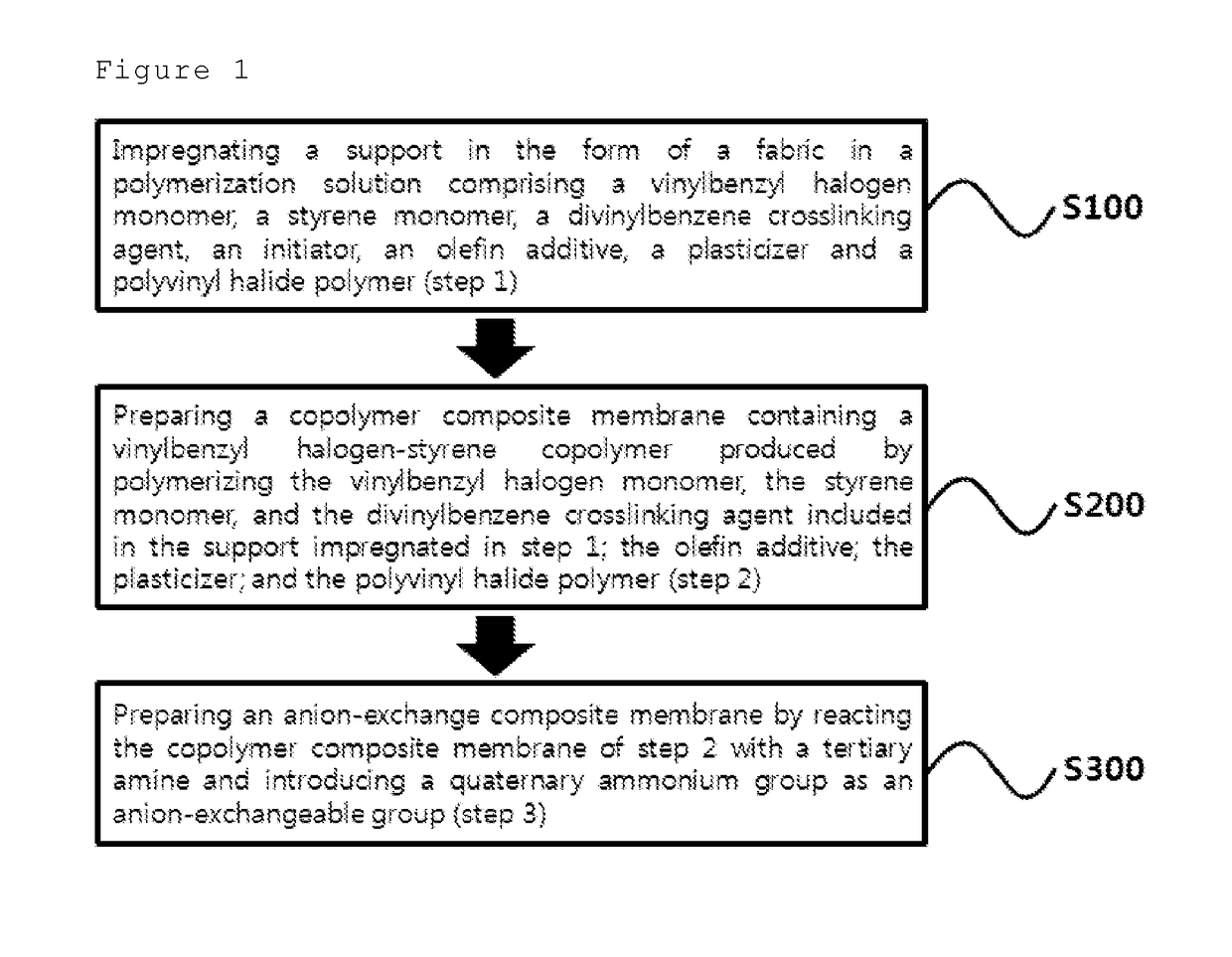Homogeneous Anion-Exchange Composite Membrane Having Excellent Chemical Resistance and Method for Producing the Same
- Summary
- Abstract
- Description
- Claims
- Application Information
AI Technical Summary
Benefits of technology
Problems solved by technology
Method used
Image
Examples
example 1
on of an Anion-Exchange Composite Membrane Containing PVDF-1
[0100]Step 1: Vinylbenzyl chloride, styrene and divinylbenzene monomers were mixed in the weight ratio of 60:30:10, to which 1 weight % of benzoyl peroxide (BPO) was added by 100 weight % of the monomer mixture as an initiator. A polymerization solution was prepared by adding PVDF at the concentration of 5 weight parts by 100 weight parts of the mixture. Then, a polyethylene support in the form of a fabric having the thickness of about 180 μm was impregnated in the polymerization solution for 4 hours.
[0101]Step 2: The polyethylene support impregnated in the polymerization solution in step 1 was placed on a rectangular glass plate, which was covered by another glass plate and then sealed with a tape in order to prevent the loss of the polymerization solution. The glass plate was placed in an oven, followed by polymerization at 65° C. for 16 hours to prepare a copolymer composite membrane precursor. Upon completion of the pol...
example 2
on of an Anion-Exchange Composite Membrane Containing PVDF-2
[0103]Step 1: Vinylbenzyl chloride, styrene and divinylbenzene monomers were mixed in the weight ratio of 60:25:15, to which 1 weight % of benzoyl peroxide (BPO) was added by 100 weight % of the monomer mixture as an initiator. A polymerization solution was prepared by adding PVDF at the concentration of 10 weight parts by 100 weight parts of the mixture. Then, a polypropylene support in the form of a fabric having the thickness of about 180 μm was impregnated in the polymerization solution for 3 hours.
[0104]Step 2: The polypropylene support impregnated in the polymerization solution in step 1 was placed on a rectangular glass plate, which was covered by another glass plate and then sealed with a tape in order to prevent the loss of the polymerization solution. The glass plate was placed in an oven, followed by polymerization at 65° C. for 16 hours to prepare a copolymer composite membrane precursor. Upon completion of the ...
example 3
on of an Anion-Exchange Composite Membrane Containing PVDF-3
[0106]Step 1: Vinylbenzyl chloride, styrene and divinylbenzene monomers were mixed in the weight ratio of 60:25:15, to which 1 weight % of benzoyl peroxide (BPO) was added by 100 weight % of the monomer mixture as an initiator. A polymerization solution was prepared by adding PVDF at the concentration of 20 weight parts by 100 weight parts of the mixture. Then, a polyvinyl chloride support in the form of a fabric having the thickness of about 180 μm was impregnated in the polymerization solution for 4 hours.
[0107]Step 2: The polyvinyl chloride support impregnated in the polymerization solution in step 1 was placed on a rectangular glass plate, which was covered by another glass plate and then sealed with a tape in order to prevent the loss of the polymerization solution. The glass plate was placed in an oven, followed by polymerization at 80° C. for 16 hours to prepare a copolymer composite membrane precursor. Upon completi...
PUM
| Property | Measurement | Unit |
|---|---|---|
| Temperature | aaaaa | aaaaa |
| Time | aaaaa | aaaaa |
| Molar mass | aaaaa | aaaaa |
Abstract
Description
Claims
Application Information
 Login to View More
Login to View More - R&D
- Intellectual Property
- Life Sciences
- Materials
- Tech Scout
- Unparalleled Data Quality
- Higher Quality Content
- 60% Fewer Hallucinations
Browse by: Latest US Patents, China's latest patents, Technical Efficacy Thesaurus, Application Domain, Technology Topic, Popular Technical Reports.
© 2025 PatSnap. All rights reserved.Legal|Privacy policy|Modern Slavery Act Transparency Statement|Sitemap|About US| Contact US: help@patsnap.com



